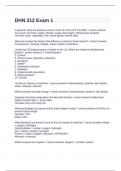-
1. Exam (elaborations) - Dhn 212 final exam with correct solutions 2024
-
2. Exam (elaborations) - Dhn 101 exam 3: ch. 9-11 with 100% correct solutions 2024
-
3. Exam (elaborations) - Dhn 312 exam with correct solutions 2024
-
4. Exam (elaborations) - Dhn final exam with correct answers 2024
-
5. Exam (elaborations) - Exam 1 dhn 101 uky exam with correct answers 2024
-
6. Exam (elaborations) - Dhn 212 exam 1 uky with correct answers 2024
-
7. Exam (elaborations) - Dhn 101 exam 2 (ch. 5-7) with correct answers 2024
-
8. Exam (elaborations) - Dhn 212 exam with correct answers 2024
-
9. Exam (elaborations) - Dhn 342 exam 2 study guide exam with correct answers 2024
-
10. Exam (elaborations) - Dhn 101 - chapter 1 terms exam with correct solutions 2024
-
11. Exam (elaborations) - Dhn 212 exam with 100% correct answers 2024
-
12. Exam (elaborations) - Dhn exam with correct answers 2024
-
13. Exam (elaborations) - Dhn 101 exam 1, dhn exam 1, dhn exam withnb correct answers 2024
-
14. Exam (elaborations) - Dhn 101 exam with correct answers 2024
-
15. Exam (elaborations) - Dhn exam 1, dhn exam with correct solutions 2024
-
16. Exam (elaborations) - Dhn exam 3 with correct solutions 2024
-
17. Exam (elaborations) - Uk dhn 101 exam with correct answers 2024
-
18. Exam (elaborations) - Dhn exam with correct answers 2024
-
19. Exam (elaborations) - Dhn 212 final exam with correct solutions 2024
-
20. Exam (elaborations) - Dhn 101 exam with correct solutions 2024
-
21. Exam (elaborations) - Dhn 212 - exam with correct solutions 2024
-
22. Exam (elaborations) - Dhn exam 1 questions for final exam w3ith correct answerts 2024
-
23. Exam (elaborations) - Dhn exam with correct answers 2024
-
24. Exam (elaborations) - Uky stephenson dhn 212 final exam with 100% correct solutions 2024
-
25. Exam (elaborations) - Dhn 302 exam 2 quizzes/lab questions exam with correct answers 2024
-
26. Exam (elaborations) - Dhn 101 final exam with correct answers 2024
-
27. Exam (elaborations) - Dhn 101-201: notes for exam with correct answers 2024
-
28. Exam (elaborations) - Dhn 212 chapter 13 exam with correct answers 2024
-
29. Exam (elaborations) - Dhn 212 exam with correct answers 2024
-
30. Exam (elaborations) - Dhn 311 exam with correct answers 2024
-
31. Exam (elaborations) - Dhn 313 exam #2 with correct answers 2024
-
32. Exam (elaborations) - Dhn 212 - final exam with correct answers 2024
-
33. Exam (elaborations) - Dhn 598 exam with correct answers 2024
-
34. Exam (elaborations) - Dhn 101 exam with correct answers 2024
-
35. Exam (elaborations) - Dhn chapters 1-4 exam with correct answers 2024
-
36. Exam (elaborations) - Dhn 313 exam with correct answers 2024
-
37. Exam (elaborations) - Exam 2 (dhn 101 - ch. 5-7) with correct solutions 2024
-
38. Exam (elaborations) - Dhn 311 exam with correct solutions 2024
-
39. Exam (elaborations) - Dhn 302 final exam with correct answers 2024
-
40. Exam (elaborations) - Dhn 212 exam with correct answers 2024
-
41. Exam (elaborations) - Dhn 241 exam with correct answers 2024
-
42. Exam (elaborations) - Dhn 101 chapter 5, carbohydrates exam with correct answers 2024
-
43. Exam (elaborations) - Dhn 101 exam with correct answers 2024
-
44. Exam (elaborations) - Dhn 212 chapter 11 review exam with correct answers 2024
-
45. Exam (elaborations) - Dhn 313 exam with correct answers 2024
-
46. Exam (elaborations) - Dhn 312 exam with correct answers 2024
-
47. Exam (elaborations) - Dhn 212 chapter 4 exam with correct answers 2024
-
48. Exam (elaborations) - Dhn exam exam with correct answers 2024
-
49. Exam (elaborations) - Dhn exam with correct answers 2024
-
50. Exam (elaborations) - Uky stephenson dhn 212 exam with correct answers 2024
-
51. Exam (elaborations) - Dhn 101 final exam with correct answers 2024
-
52. Exam (elaborations) - Dhn 312 final exam with correct answers 2024
-
53. Exam (elaborations) - Dhn final exam with correct answers 2024
-
54. Exam (elaborations) - Dhn 302 final exam with correct answers 2024
-
55. Exam (elaborations) - Uk dhn 101 exam with correct answers 2024
-
56. Exam (elaborations) - Dhn 510 exam with correct answers 2024
-
57. Exam (elaborations) - Dhn 212 exam with correct answers 2024
-
58. Exam (elaborations) - Dhn 517 final exam with correct answers 2024
-
59. Exam (elaborations) - Uky stephenson dhn 212 exam with correct answers 2024
-
60. Exam (elaborations) - Dhn 101 exam 2 (ch. 5-7) with correct answers 2024
-
61. Exam (elaborations) - Dhn 510 exam with correct answers 2024
-
62. Exam (elaborations) - Dhn 212 exam with correct answers 2024
-
63. Exam (elaborations) - Dhn 101 exam with correct answers 2024
-
Show more




